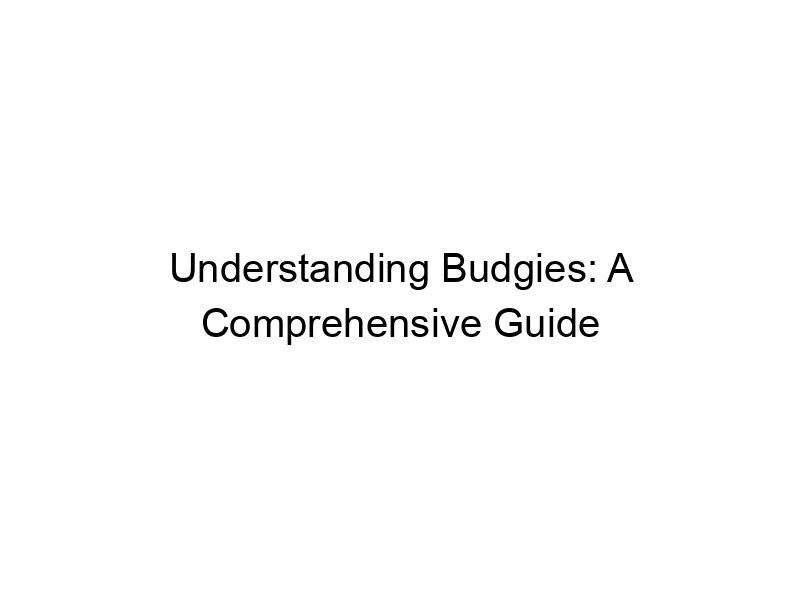Are you thinking of welcoming a feathered friend into your home? This comprehensive guide dives deep into the world of budgies, also known as parakeets, providing everything you need to know to become a responsible and loving budgie owner. Budgies 101: Everything You Need to Know About These Charming Birds covers everything from choosing the right bird to ensuring its lifelong health and happiness. We’ll explore their behavior, dietary needs, housing requirements, and much more, making you a budgie expert in no time.
Budgerigars, commonly known as budgies or parakeets, are small, vibrant birds belonging to the Melopsittacus undulatus species. Native to Australia, they’ve become incredibly popular pets worldwide due to their striking colors, relatively small size, and engaging personalities. Their cheerful chirps and playful antics make them delightful companions for people of all ages.
Budgies
typically live for 5-8 years, though some can live even longer with proper care. They are relatively small birds, measuring around 6-7 inches in length from beak to tail. Their size makes them suitable for apartment living, but remember they still need ample space to fly and play.
Common Budgie Colors and Mutations
Wild budgies are predominantly green, but selective breeding has resulted in a stunning array of colors and patterns. You’ll find budgies in shades of blue, yellow, white, grey, and even combinations of these colors. Certain mutations affect the texture and appearance of their feathers, adding to their visual diversity. Examples include the spangled, opaline, and cinnamon mutations.
Choosing Your Budgie
Selecting a Healthy Budgie
Choosing a healthy budgie is crucial for its well-being. Look for a bird with bright, clear eyes, smooth feathers, and a clean beak and vent. Avoid birds that appear lethargic, have ruffled feathers, or show signs of respiratory distress. A reputable breeder or pet store will be able to provide guidance.
Male vs. Female Budgies
Male budgies typically have a vibrant blue cere (the fleshy area above the beak), while female ceres vary in color, often being brown or tan. However, this isn’t always a reliable indicator, and DNA testing can provide a definitive answer if needed. Both male and female budgies can make wonderful pets.
Single Budgie vs. Budgie Pair
Budgies are social creatures and can thrive alone, especially with plenty of interaction from their human companions. However, they can also be kept in pairs. A pair of budgies will provide each other with companionship, but be prepared for increased noise levels and potential for breeding.
Housing Your Budgie
Choosing the Right Cage
Your budgie’s cage should be spacious enough to allow for flight and movement. A minimum size of 24 inches wide, 18 inches deep, and 30 inches tall is recommended. Wire cages are generally preferable to plastic ones, ensuring good ventilation. Avoid cages with narrow bars that could trap their feet.
Cage Accessories and Placement
Provide a variety of toys, including swings, bells, and ladders to keep your budgie entertained and mentally stimulated. Perches of varying diameters and materials should also be included. The cage should be placed in a well-lit area, away from drafts and direct sunlight.
Budgie Diet and Nutrition
Essential Nutrients for Budgies
A budgie’s diet should consist primarily of high-quality seed mix specifically formulated for budgies. Supplement this with fresh vegetables, fruits, and occasional treats like millet sprays. Avoid foods high in fat, sugar, or salt. A balanced diet will ensure your budgie remains healthy and vibrant.
Providing Fresh Water
Always provide fresh, clean water in a clean food and water bowl or dispenser. Change the water daily to prevent the growth of harmful bacteria. Using a water bottle will reduce chances of the water getting contaminated with droppings.
Budgie Health and Hygiene
Signs of a Sick Budgie
Watch for signs of illness such as lethargy, ruffled feathers, loss of appetite, respiratory distress, or changes in droppings. If you notice any of these symptoms, consult an avian veterinarian immediately. Early intervention is crucial for successful treatment.
Routine Vet Checkups
Regular veterinary checkups are essential for maintaining your budgie’s health. An avian vet can perform routine examinations, administer necessary vaccinations, and provide guidance on proper care. Preventative care is always better than reactive care.
Budgie Behavior and Training
Understanding Budgie Communication
Budgies communicate through a variety of vocalizations, body language, and gestures. Learn to recognize these signals to understand your budgie’s needs and mood. Chirping, whistling, and changes in posture can all indicate different emotions or states of being.
Basic Budgie Training Techniques
Budgies are intelligent birds and can be trained to perform simple tricks, such as stepping up onto your finger or returning to their cage. Positive reinforcement methods, such as rewarding good behavior with treats or praise, are the most effective. Patience and consistency are key.
Breeding Budgies (Optional)
Considerations Before Breeding
Breeding budgies is a significant commitment requiring careful planning and preparation. Ensure you have adequate space, resources, and knowledge before undertaking this endeavor. Responsible breeding practices are essential to prevent overcrowding and the spread of genetic diseases.
Breeding Setup and Care
A breeding cage should be larger than a standard cage and include a nesting box. Proper nutrition is vital for successful breeding, and close monitoring of the parents and chicks is crucial. Providing a clean and stimulating environment will maximize the chances of successful hatching and chick rearing.
Frequently Asked Questions
What is the average cost of owning a budgie?
The initial cost of acquiring a budgie can range from $20 to $50, depending on the breeder and the bird’s coloration. Ongoing costs include food, cage, toys, vet visits, and other supplies, which can add up to approximately $50-$100 per year.
How much space does a budgie need?
Budgies need a cage that’s spacious enough for them to fly around and stretch their wings. A minimum cage size of 24 inches wide, 18 inches deep, and 30 inches tall is recommended. Larger cages are always better.
Are budgies noisy?
Budgies can be relatively noisy birds, especially during the morning and evening hours. While their chirping can be pleasant, it’s crucial to consider this factor before bringing a budgie into your home, especially if you live in an apartment or have noise-sensitive neighbours.
Can budgies be left alone for long periods?
Budgies should not be left alone for extended periods. They are social creatures that need interaction and attention. Ideally, they should have someone interacting with them at least once or twice a day for a while.
How do I keep my budgie’s cage clean?
Regular cleaning is essential to maintain a healthy environment for your budgie. Spot clean the cage daily, removing droppings and soiled food. Completely clean and disinfect the cage once a week using a safe, bird-friendly cleaning solution.
Final Thoughts
Owning a budgie is a rewarding experience, offering companionship, entertainment, and a connection to nature. By understanding their needs and providing a safe, stimulating environment, you can ensure your budgie thrives and becomes a beloved member of your family. This guide has provided you with the essential information to embark on this journey. Remember that consistent care and attention are key to a happy and healthy budgie. So, whether you’re a beginner or a seasoned bird enthusiast, continue learning and observing your budgie to create the best possible home for your feathered friend. Start creating a fantastic environment today, and enjoy the many joys of budgie ownership! Remember to always consult a veterinarian if you have any concerns about your budgie’s health.




